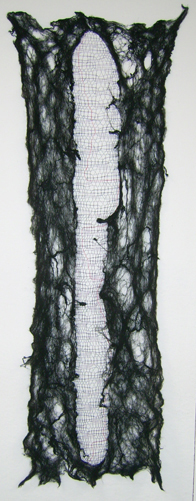
| |
| Home |
| Gallery |
| Exhibitions |
| CV |
| Contact |
| Cover Cloth |
Failure to observe the law brought a fine of £5. However it was considered a great privilege and honour to be buried in lace and many people preferred to pay the fine and to be buried in their best lace. Mrs Oldfield, a famous 18th century actress and lace collector, was buried in Westminster Abbey, in 1830, in a Holland shift with a tucker of double ruffles, and a fine Brussels lace ‘head’. Even highwaymen thought it their duty to put on a good show and went to the gallows in their best lace in the hope that they would be buried in it. Cover Cloth references not only the Burial in Wool Act but also the fact that the coffins excavated from the vaults in Christ Church, Spitalfields, were covered in woollen cloth. There are numerous fragments of woollen cloth amongst the artefacts from the excavations. The outer section of the work is cobweb felt, made from Merino wool. The central lace panel is based on the identification code used for Master Silk Weaver Charles Mesman and includes a single red threads that can be read as a lifeline. |
